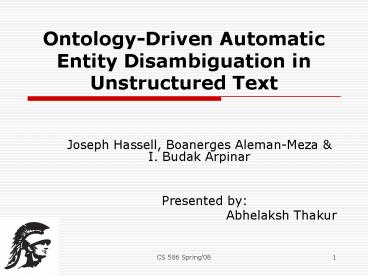OntologyDriven Automatic Entity Disambiguation in Unstructured Text
1 / 24
Title:
OntologyDriven Automatic Entity Disambiguation in Unstructured Text
Description:
To create a method to disambiguate entities within unstructured text by using ... Set of entities found by our algo (B) Precision = size of (A B)/size of (B) ... –
Number of Views:41
Avg rating:3.0/5.0
Title: OntologyDriven Automatic Entity Disambiguation in Unstructured Text
1
Ontology-Driven Automatic Entity Disambiguation
inUnstructured Text
- Joseph Hassell, Boanerges Aleman-Meza I. Budak
Arpinar - Presented by
- Abhelaksh Thakur
2
What is the paper about?
- Problem Entity Disambiguation
- How to exploit background information for entity
disambiguation? - Aim
- To create a method to disambiguate entities
within unstructured text by using clues in the
text and exploiting metadata from an ontology. - Also to provide an implementation of the method
using a very large, real world ontology. - Dataset used
- Approach
- Algorithm
- Evaluation of the algorithm (Precision Recall)
- Related Work
- Future work
3
TERMS USED
- Entity disambiguation
- Ontology
- Semantic web
- RDF
- DBLP
- DBWorld
4
DATASET
- DBLP Digital Bibliography Library Project
- Contains bibliographic information for computer
science researchers, journals and proceedings. - it indexes more than 725,000 articles and
contains a few thousand links to home pages of
computer scientists. - It provides two XML files
- First contains objects such as authors,
proceedings and journals. - Second contains lists of papers.
- The first XML file was converted into an RDF
containing 3,079,414 entities.
5
DATASET(cont.)
- DBWorld
- DBWorld is a mailing list of information for
upcoming conferences related to the databases
field. - An HTML scraper was created that visits the
DBWorld site and downloads only the posts that
contain Call for Papers, Call for
Participation or CFP in the subject - The system disambiguates the people listed in
these postings and provides a URI to the
corresponding entity in the ontology.
6
APPROACH
- Aim To find the correct entity out of the
various possible matches.
7
APPROACH (cont.)
- Scenario Disambiguating researchers by their
names appearing in the DBWorld postings. - Spotting entity names.
- Text proximity relationships.
- Text Co-occurrence Relationships.
- Popular Entities.
- Semantic Relationships.
8
(No Transcript)
9
ENTITY DISAMBIGUATION ALGORITHM- Terms Used
- es confidence score
- cf initial confidence score
- acf initial abbreviated confidence score
- pr proximity score
- co text occurrence score
- sr semantic relationship score
- pe popular entity score
10
ENTITY DISAMBIGUATION ALGORITHM
- Step 1 Spot Entity Names
- es cf / no. of entities with
- same label
- es acf / no. of related entities in
- the ontology
- acf feature is used for abbreviated names and
can be turned on or off.
11
- Step 2 Spot literal value of Text-proximity
relationships - es espr if Text-proximity relationship found
near candidate entity
12
- Step 3 Spot literal value of Text-co occurrence
relationships - es esco if text co occurrence relationship
found. - Step 4 Using popular entities
- es espe for those entities that have many
relationships that were predefined as popular.
13
- Step 5 Using semantic relationships
- esessr
- a) Choose candidate entity with highest es and
increase es of entities that have semantic
relationships (eg. co-authorship) in ontology
with it. - b) Ignore candidate entity with low es.
14
- Step 5 (contd.)
- Threshold es es(t)
- Iterate till atleast one candidate entity gets
its es increased over es(t).
15
ENTITY DISAMBIGUATION ALGORITHM
- Algorithm Disambiguation( )
- for (each entity in ontology)
- if (entity found in document)
- create candidate entity
- es for candidate entity lt- cf / (entities in
ontology) - for (each candidate entity)
- search for candidate entitys text proximity
relationship - if (text proximity relationship found near
candidate entity) - es for candidate entity lt- es for candidate
entity pr - search for candidate entitys text
co-occurrence relationship - if (text co-occurrence relationship found)
- es for candidate entity lt- es for candidate
entity co - if (ten or more popular entity relationships
exist) - es for candidate entity lt- es for candidate
entity pe
16
SAMPLE OUTPUT OF THE ALGORITHM
17
EVALUATION OF THE ALGORITHM
- Disambiguated dataset (A)
- Set of entities found by our algo (B)
- Precision size of (A n B)/size of (B)
- Recall size of ( A n B)/size of (A)
18
INPUT SETTINGS
- Description Variable
Value - charOffset
50 - Text proximity relationships pr
50 - Text co-occurrence relationships co
10 - Popular entity score pe
10 - Semantic relationship sr
20 - Initial confidence score cf
90 - Initial abbreviated confidence
- score acf
70 - Threshold threshold
90
19
RESULTS
- Correct Disambiguation 602(A n B)
- Found Entities 620 (B)
- Total Entities 758 (A)
- Precision 97.1
- Recall 79.4
20
MEASURE OF PRECISION RECALL ON PER-DOCUMENT
BASIS
21
CHARACTERISTICS OF THE ALGORITHM
- Performs well on unstructured text
- Reduces need for string similarity computations.
- Does not require training data
22
RELATED WORK
- KIM
- Automatic ontology population system.
- Natural language processor/ indexing.
- SCORE
- Semantic metadata management system
- Uses associations from knowledgebase.
- It is a commercial system.
- ESpotter
- Uses a lexicon and/or patterns to recognize named
entities.
23
FUTURE WORK
- Integration of results of entity disambiguation
into a more robust platform like UIMA
(Unstructured Information Management Architecture)
24
THANK YOU..!!



























![[Fixed] Recover Deleted Text Messages Android without Root](https://s3.amazonaws.com/images.powershow.com/9240286.th0.jpg?_=20190322055)



